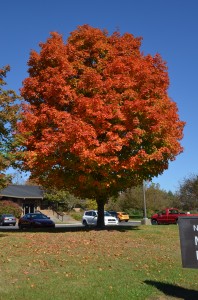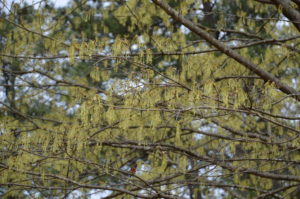Sugar maple (Acer saccharum) is a native deciduous tree often planted as a large shade or street tree. It commonly grows 60 to 75 feet (and taller) with a dense rounded foliage canopy. Native to central and eastern North America regions, sugar maple grows best in fertile, mildly acidic, moist well-drained soils and in full sun to part shade.
The 5-lobed deep green leaves of summer takes on yellow, orange and red shades in the autumn. Clusters of yellowish-green flowers appear in mid-spring a week before the leaves emerge. Flowers ripen into clustered pairs of double-winged samaras (or “helicopters”) in late summer. In the winter tree trunks may be tapped for maple syrup (“saccharum” means sugar).
Disease and pest problems are less when properly sited and maintained. Do not plant in dry compacted sites such as in downtown parking lots or as street trees. Poor locations bring on numerous serious diseases and insects, including verticillium and fusarium wilts, leaf spots, cankers, wood borers and scale. Its shallow roots raise up urban sidewalks.There are more than 25 sugar maple cultivars, and here are three exceptional ones.
‘Green Mountain’ has broadly pyramidal tree form. The foliage may struggle in summer heat and dry periods, causing leaf edges to brown (scorch). However, its thick deep green foliage is resistant to leaf hoppers and scorch, making it an ok choice as a street tree.
‘Legacy’ sugar is a more heat and drought resistant, making it a good pick for the southeastern U.S. The tree canopy is densely branched and has glossy thick green leaves. The leaves turn yellow to orange in autumn.
‘Green Column’ (A. saccharum subsp. Nigrum), aka black maple, exhibits better than average heat and drought resistances. Summer foliage is dark green and is thick and leathery to the touch. It develops a yellow fall color that’s two weeks later than other sugar maples.



 Posted in
Posted in 
